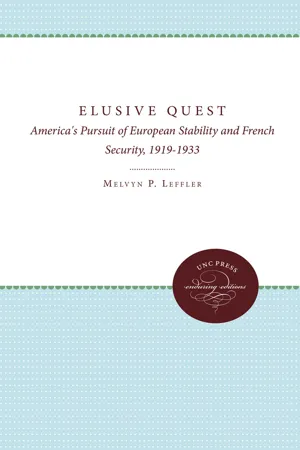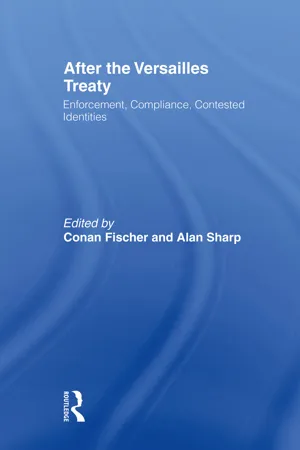History
Young Plan
The Young Plan was a program for settling German reparations debts after World War I. It was proposed by American Owen D. Young and adopted in 1929. The plan reduced Germany's reparation payments and extended the timeline for payment, aiming to ease the economic burden on Germany and promote stability in Europe.
Written by Perlego with AI-assistance
Related key terms
Related key terms
1 of 4
Related key terms
1 of 3
4 Key excerpts on "Young Plan"
- eBook - ePub
The Story of International Relations, Part Two
Cold-Blooded Idealists
- Jo-Anne Pemberton(Author)
- 2020(Publication Date)
- Palgrave Macmillan(Publisher)
The Young Plan, which superseded in 1930 the Dawes Plan as the scheme under which Germany made its reparation payments and which revised downwards the total German annuity from around 2,500,000,000 marks to an average of around 2,000,000,000 marks, divided these payments into two components: an unconditional component set at 612,000,000 marks and a conditional component that amounted to an average of around 1,400,000,000 marks. According to Hamilton Fish Armstrong, the editor of the monthly journal of the Council on Foreign Relations (CFR), namely, Foreign Affairs, the unconditional amount, which had to be paid in foreign currency and which was not subject to postponement, was made relatively small with a view to precluding any doubts about Germany’s capacity to pay it. In contrast with the unconditional amount, the conditional component could be paid in Reichsmarks rather than in a foreign currency and was subject to postponement. 32 The onset of the Depression overturned the assumption on which the Young Plan was based. The Young Plan, with its rising series of annuities, contemplated a steady expansion of world trade, not merely in volume but in value, in which the annuities payable by Germany would become a factor of diminishing importance. In fact, the opposite has been the case. Since the Young Plan came into effect, not only has the trade of the world shrunk in volume, but the very exceptional fall in gold prices that has occurred in the last two years has itself added to the real burden not only of the German annuities but of all payments fixed in gold. 33 On 20 June 1931, in the midst of the deepening of the Depression, President Hoover proposed a one-year moratorium on reparation payments as well as all war debts. It was becoming apparent, certainly to the Germans themselves, that Germany could not continue to pay the annuities prescribed by the Young Plan on which Germany’s creditors relied in order to pay their war debts to the United States - eBook - ePub
The Elusive Quest
America's Pursuit of European Stability and French Security, 1919-1933
- Melvyn P. Leffler(Author)
- 2017(Publication Date)
- The University of North Carolina Press(Publisher)
But the Young Plan stipulated that, should the Allies secure reductions in their own obligations, a large percentage of those benefits would be passed on to Germany. Finally, the Young Plan provided for the establishment of the BIS. This institution was expected to distribute the reparation annuities, help finance deliveries-in-kind, facilitate international transfers, and promote world commerce. In addition, the BIS was charged with the responsibility of convening a special advisory committee should Germany ever decide to activate the safeguard clause and postpone the conditional payments. 44 Though they endorsed the Young Plan, the American experts recognized its limitations. Young and Lamont acknowledged that all of the experts had been responsive to the demands of their governments. 45 But since political imperatives and economic realities eventually had to be reconciled if governments were to accept their recommendations, the American experts had few regrets. They felt they had succeeded in framing a document that was economically viable yet politically acceptable. 46 There were, however, many imponderables. The plan was based on a set of interrelated assumptions that the German economy would continue to grow, foreign loans would stimulate German productivity, German exports would eventually exceed imports, German budgetary problems would be resolved, and the relatively large payments demanded after ten years would be paid. Although the stock market crash and the onset of the Depression lay only a few months ahead, almost no one foresaw that these assumptions would be so quickly discredited. 47 During 1929 and early 1930 American bankers, economists, and financial analysts debated the economic merits of the Young Plan. Some contended that it imposed too heavy a burden on Germany, but even they qualified their criticisms. At the time Germany’s economic development seemed impressive, and many of her financial problems appeared soluble - eBook - ePub
American Business and Foreign Policy
1920–1933
- Joan Hoff Wilson(Author)
- 2021(Publication Date)
- The University Press of Kentucky(Publisher)
Uniting as they had been unable to do over the question of Allied debts, these businessmen argued that both plans scaled down the reparation payments to Germany’s postwar capacity to pay. Thomas Lamont went so far as to call the international loan accompanying the Young Plan “the final liquidation of the War so far as the settlement of great economic questions is concerned.” There was also a consensus among business internationalists that the two commissions represented a “new practical idealism” in the conduct of foreign affairs whereby the “old diplomatic method of international dealing” between politicians had been replaced with unofficial conferences conducted by businessmen acting as private citizens. The business community and public in general accepted these positive generalizations about the Dawes and Young settlements without any real understanding of the technicalities involved. One such technicality was the fact that, despite the predominance of economic expertise in the negotiations, both were political adjustments of the reparations question based on large loans to Germany which were not self-liquidating. This meant that in the long run they exacerbated the balance-of-payments problem for the lending countries, especially England, as well as for Germany. 58 This blind support from within the business community undermined any practical consideration of alternative solutions and prevented most legitimate criticism of the plans from enlightening public opinion on the entire question of reparations and their relation to the war debts. The American Association Favoring Reconsideration of the War Debts did devote considerable effort to a critique of the operation of the Dawes Plan in 1927, but aside from Newton D. Baker, George W. Wickersham, and Henry B. Joy, former president of the Packard Motor Company, few prominent politicians or business figures aided the efforts of this organization - eBook - ePub
After the Versailles Treaty
Enforcement, Compliance, Contested Identities
- Conan Fischer, Alan Sharp(Authors)
- 2013(Publication Date)
- Routledge(Publisher)
Reparation (reprinted New York, 1965).15. Their views echoed best-selling historical studies of the day, notably Thomas A. Bailey’s two widely read studies of the Paris Peace Conference and the League. Thomas J. Knock, To End All Wars. Woodrow Wilson and the Quest for a New World Order (Oxford, 1992), p. 272 notes the “extraordinary recovery” of Wilson’s stock after 1941 for a season of three or four years culminating in Truman’s announcement in the summer of 1945 that the Charter of the United Nations had at last vindicated Wilson.16. Steven Schuker, The end of French Predominance in Europe: The Financial Crisis of 1924 and the Adoption of the Dawes Plan (Chapel Hill, 1976); Marc Trachtenberg, Reparation in World Politics: France and European Economic Diplomacy 1916–1923 (New York 1980); and Stanislas Jeannesson, Poincaré, la France et la Ruhr (1922–1924). Histoire d’une Occupation (Strasbourg, 1998).17. For problems this caused in the 1920s, see Frank Costigliola, Awkward Dominion: American Political Economic and Cultural Relations with Europe, 1919–1933 (Cornell, 1984). For the 1930s, see Patricia Clavin, The Failure of Economic Diplomacy. Britain, Germany, France and the United States, 1931 (London, 1996); and Patricia Clavin, Europe and the Great Depression, 1929–1939 (London, 2000), chs. 6 and 7 .18. NARA RG 59.3.8, Economic Committee, 1940–16, Box 49, Reparation Memo 11, Subcommittee 3, “The Reparation Problem: Experience after World War 1,” Feb., 28 1944, p. 7.19. Ibid. p. 8.20. The Allies’ failure facilitated the development of “a spirit of reckless opportunism among German industrial and financial leaders and a feeling of discouragement among the professional classes.” See NARA RG 59.3.8, Economic Committee, 1940–46, Box 49, Reparation Memo 11, Subcommittee 3, “The Reparation Problem: Experience after World War 1,” Feb. 28, 1944, pp. 8–9. For a modern echo see G. D. Feldman, The Great Disorder: Politics, Economics and society in the German Inflation
Index pages curate the most relevant extracts from our library of academic textbooks. They’ve been created using an in-house natural language model (NLM), each adding context and meaning to key research topics.
Explore more topic indexes
Explore more topic indexes
1 of 6
Explore more topic indexes
1 of 4



